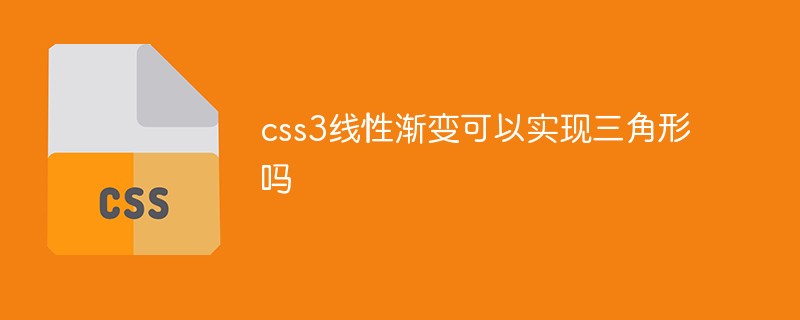The new pseudo-class selectors are: 1. ":root", matching the root element of the document; 2. ":first-child", matching the first child element of the parent element; 3. ": last-child", matches the last child element of the parent element; 4. ":empty", matches empty elements; 5. ":target" and so on.

The operating environment of this tutorial: Windows 7 system, CSS3&&HTML5 version, Dell G3 computer.
The role of pseudo-class selectors: further restrict existing selectors and further filter elements that can be matched by existing selectors. The pseudo-class selectors provided by CSS 3 are mainly divided into the following three categories:
- Structural pseudo-class selector
- UI element state pseudo-class selector
- Others Pseudo-class selector
1. Structural pseudo-class selector
- :root: matches the root element of the document . In an HTML document, the root element is always the
element. - :first-child: Matches elements that match the selector and must be the first child node of its parent element.
- :last-child: Matches elements that match the selector and must be the last child node of its parent element.
- :nth-child(n): Matches elements that match the selector and must be the nth child node of its parent element.
- :nth-last-child(n): Matches elements that match the selector and must be the nth child node from the bottom of its parent element.
- :only-child: Matches elements that match the selector and must be the only child node of its parent element.
- :first-of-type: matches the selector and is the first element among its sibling elements of the same type and level.
- :last-of-type: matches the selector and is the last element among its sibling elements of the same type and level.
- :nth-of-type(n): Matches the nth element that matches the selector and is the nth element among its sibling elements of the same type and level.
- :nth-last-of-type(n): matches the selector and is the nth element from the last among its sibling elements of the same type and level
- :only -of-type: matches the selector and is the only element among its sibling elements of the same type and level.
- :empty: Matches elements that match the selector and do not have any child elements (including text nodes) inside them.
- :lang(lang): Matches elements that match the selector and whose content is in a specific language.
For the two pseudo-class selectors: nth-child and :nth-last-child, the following usage is also supported.
:nth-child(odd/event): Matches elements that match the selector and must be the odd/even child node of its parent element
:nth-last-child( odd/event): Matches the element that matches the selector and must be the odd/even child node of its parent element
:nth-child(xn y): Matches the selector and must be its parent element The element of the xn yth child node of the parent element
:nth-last-child(xn y): Matches the element that matches the selector and must be the xn yth child node of its parent element
An example of using the :nth-last-child pseudo-class selector is as follows:
<meta>
<meta>
<title> child </title>
<style>
/* 定义对作为其父元素的倒数第3n 1个(1、4、7)子节点
的li元素起作用的CSS样式 */
li:nth-last-child(3n+1) {
background-color: #FFC0CB;
}
</style>
- Java
- 轻量级Java EE
- Ajax
- XML
- 经典Java EE
- Android
The effect is as follows:

2. UI element status pseudo-class selector
UI element status pseudo-class selector includes:
:enabled : Matches all elements in the available state in the user interface (form form)
: disabled: Matches all elements in the disabled state in the user interface (form form)
:checked: Matches all selected elements in the user interface (form form)
::selection (there are two colons in front of the selector): Match the part of the element that is selected or highlighted by the user
3. Other pseudo-class selectors
3.1: Target pseudo-class selector (matches elements that match the selector and must be the target of a named anchor)
It is required that the element must be the target of the named anchor and must be currently being accessed The goal. Its purpose is that the page can highlight the target being visited through this selector. The following demonstrates the usage of the target selector (the code is the sample code in "Crazy HTML 5 CSS 3 JavaScript Handouts")
<meta>
<title> :target </title>
<style>
:target {
background-color: #ff0;
}
</style>
<p>
<a>疯狂Java讲义</a> |
<a>轻量级Java EE企业应用实战</a> |
<a>疯狂Android讲义</a> |
<a>经典Java EE企业应用实战</a>
</p>
<div>
<h2 id="疯狂Java讲义">疯狂Java讲义</h2>
<p>本书详细介绍了Java语言各方面的内容。</p>
</div>
<div>
<h2 id="轻量级Java-EE企业应用实战">轻量级Java EE企业应用实战</h2>
<p>本书详细介绍Struts 2、Spring 3、Hibernate三个框架整合开发的知识</p>
</div>
<div>
<h2 id="疯狂Android讲义">疯狂Android讲义</h2>
<p>本书详细介绍了Android应用开发的知识。</p>
</div>
<div>
<h2 id="经典Java-EE企业应用实战">经典Java EE企业应用实战</h2>
<p>本书详细介绍JSF 、EJB 3、JPA等Java EE相关的知识</p>
</div>

3.2: not pseudo Class selector (matching elements that match selector 1 but not selector 2, equivalent to subtracting 2 from 1)
The code on the following page demonstrates the use of the :not selector:
<meta>
<title> :not </title>
<style>
li:not(#ajax) {
color: #999;
font-weight: bold;
}
</style>
- 疯狂Java讲义
- 轻量级Java EE企业应用实战
- 疯狂Ajax讲义
- 疯狂XML讲义
- 疯狂Android讲义

As you can see from the running results, except for the font of all
(Learning video sharing: css video tutorial, web front-end)
The above is the detailed content of What are the new pseudo-class selectors in css3?. For more information, please follow other related articles on the PHP Chinese website!
 css怎么隐藏元素但不占空间Jun 01, 2022 pm 07:15 PM
css怎么隐藏元素但不占空间Jun 01, 2022 pm 07:15 PM两种方法:1、利用display属性,只需给元素添加“display:none;”样式即可。2、利用position和top属性设置元素绝对定位来隐藏元素,只需给元素添加“position:absolute;top:-9999px;”样式。
 原来利用纯CSS也能实现文字轮播与图片轮播!Jun 10, 2022 pm 01:00 PM
原来利用纯CSS也能实现文字轮播与图片轮播!Jun 10, 2022 pm 01:00 PM怎么制作文字轮播与图片轮播?大家第一想到的是不是利用js,其实利用纯CSS也能实现文字轮播与图片轮播,下面来看看实现方法,希望对大家有所帮助!
 css3什么是自适应布局Jun 02, 2022 pm 12:05 PM
css3什么是自适应布局Jun 02, 2022 pm 12:05 PM自适应布局又称“响应式布局”,是指可以自动识别屏幕宽度、并做出相应调整的网页布局;这样的网页能够兼容多个不同的终端,而不是为每个终端做一个特定的版本。自适应布局是为解决移动端浏览网页而诞生的,能够为使用不同终端的用户提供很好的用户体验。
 css3如何实现鼠标点击图片放大Apr 25, 2022 pm 04:52 PM
css3如何实现鼠标点击图片放大Apr 25, 2022 pm 04:52 PM实现方法:1、使用“:active”选择器选中鼠标点击图片的状态;2、使用transform属性和scale()函数实现图片放大效果,语法“img:active {transform: scale(x轴放大倍数,y轴放大倍数);}”。
 css3动画效果有变形吗Apr 28, 2022 pm 02:20 PM
css3动画效果有变形吗Apr 28, 2022 pm 02:20 PMcss3中的动画效果有变形;可以利用“animation:动画属性 @keyframes ..{..{transform:变形属性}}”实现变形动画效果,animation属性用于设置动画样式,transform属性用于设置变形样式。
 css3怎么设置动画旋转速度Apr 28, 2022 pm 04:32 PM
css3怎么设置动画旋转速度Apr 28, 2022 pm 04:32 PM在css3中,可以利用“animation-timing-function”属性设置动画旋转速度,该属性用于指定动画将如何完成一个周期,设置动画的速度曲线,语法为“元素{animation-timing-function:速度属性值;}”。
 一文了解CSS3中的新特性 ::target-text 选择器Apr 12, 2022 am 11:24 AM
一文了解CSS3中的新特性 ::target-text 选择器Apr 12, 2022 am 11:24 AM本篇文章带大家一起深入了解一下CSS3中的新特性::target-text 选择器,聊聊该选择器的作用和使用方法,希望对大家有所帮助!
 css3线性渐变可以实现三角形吗Apr 25, 2022 pm 02:47 PM
css3线性渐变可以实现三角形吗Apr 25, 2022 pm 02:47 PMcss3线性渐变可以实现三角形;只需创建一个45度的线性渐变,设置渐变色为两种固定颜色,一个是三角形的颜色,另一个为透明色即可,语法“linear-gradient(45deg,颜色值,颜色值 50%,透明色 50%,透明色 100%)”。


Hot AI Tools

Undresser.AI Undress
AI-powered app for creating realistic nude photos

AI Clothes Remover
Online AI tool for removing clothes from photos.

Undress AI Tool
Undress images for free

Clothoff.io
AI clothes remover

AI Hentai Generator
Generate AI Hentai for free.

Hot Article

Hot Tools

SublimeText3 Mac version
God-level code editing software (SublimeText3)

SublimeText3 Linux new version
SublimeText3 Linux latest version

SecLists
SecLists is the ultimate security tester's companion. It is a collection of various types of lists that are frequently used during security assessments, all in one place. SecLists helps make security testing more efficient and productive by conveniently providing all the lists a security tester might need. List types include usernames, passwords, URLs, fuzzing payloads, sensitive data patterns, web shells, and more. The tester can simply pull this repository onto a new test machine and he will have access to every type of list he needs.

WebStorm Mac version
Useful JavaScript development tools

SublimeText3 English version
Recommended: Win version, supports code prompts!







